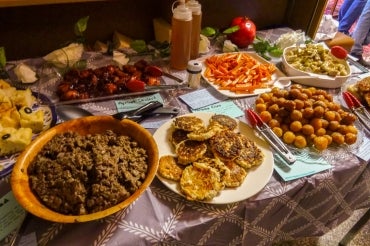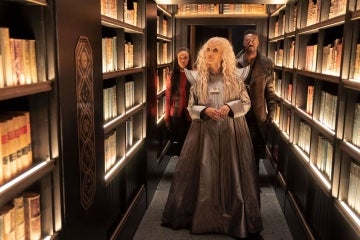Students dig into the past during 'Ancient Food Day'

Published: January 31, 2023
Did you know Ancient Greeks enjoyed a snack that resembled Timbits?
They were called enkrides – small golden cakes made with a simple cheese dough, fried in olive oil and eaten with generous amounts of honey and pepper.
Enkrides were just one of the many dishes students from the University of Toronto’s department of classics in the Faculty of Arts & Science enjoyed during a recent “Ancient Food Day.” Hosted by the Classics Student Union, about 40 students gathered at the Lillian Massey Building to sample a collection of food and drinks from ancient Greek and Roman periods.
“We believe food is the perfect vehicle for gathering people and communities,” says John Liao, a fourth-year classics student, a member of Trinity College and the president of the Classics Student Union.
“We’re thrilled to share the fruits of our own learning and love for the ancient world by offering students a unique opportunity to try real recipes from Greek and Latin sources and adapted to modern cooking.”

An apricot dessert, made with fresh apricots in honey and wine (photo by Sean McNeely)
For appetizers, students were served parsnip fries. They were sliced in thick cuts, fried in olive oil and served with a sweet and sour sauce made with vinegar, fish sauce, honey and spices.
Some of the main dishes included bite-sized tuna steaks served in a Roman sauce for fish made with honey, wine, oil and Mediterranean herbs. Crab isicia, or Roman crab cakes, were also a hit at the feast.
So, too, were the Vitellian broad beans – a dish that the Greek philosopher and mathematician, Pythagoras, would have shunned as he avoided beans at all costs. In fact, it’s believed that when choosing whether to cross a field of beans or be slain at the hands of those chasing him, he couldn’t bring himself to step into the field and was killed.
A warm cheesecake-like dish called libum was made from a simple dough of cheese, flour and egg. Libum was so tasty, it was sometimes offered as sacrificial foods to the gods. For dessert, the students savoured fresh apricots prepared with honey and wine.
Where did Liao find these ancient recipes? In the popular Greek and Roman cookbooks of that period.
One such book is the De Re Coquinaria, attributed to the first-century CE gourmand Marcus Gavius Apicius. The recipes were created for the wealthiest classes and a few contain exotic ingredients from that time, such as flamingo.
Another is the Deipnosophistae, an early third-century CE work by the Greek author Athenaeus. This book is regarded as an important resource that includes the original text of a recipe from the lost cookbook by Mithaecus, which is considered the oldest recipe by a named author in any language.

Tuna steaks prepared with an ancient Roman sauce made with honey, wine, fish oil and herbs (photo by Sean McNeely)
Other recipes come from a variety of sources, including Cato’s De Agri Cultura, which translates to “On Farming” or “On Agriculture.” Believed to be compiled around 160 BCE, it’s considered to be the oldest surviving piece of Latin prose.
The recipes were modified and altered slightly, as some of the ingredients in the original texts no longer exist, but the students dined on essentially the same foods Greeks and Romans served at dinners thousands of years ago.
Liao loved the element of timelessness.
“It’s something that is very much human, something that connects all of us,” says Liao. “We all have these very intimate memories of food and eating with others, it has such a treasured emotional space in people's lives, which I think definitely contributes to the warm, convivial atmosphere and popularity of an event like this.”
He was also pleased to see a collection of empty plates and bowls. “I really enjoyed seeing how much other people enjoyed this event,” he says. “I was playing the pushy, travelling salesman, trying to get people to try different dishes. And it was really nice to hear people praising the food, or when you get someone to try something they haven't tried before, and their eyes light up.”

A collection of Greek- and Roman-inspired drinks made from fruits such as pomegranates and raisins (photo by Sean McNeely)
Victoria Wohl, chair of the department of classics, attended the event and says she was delighted to see the filled plates and lively discussion. For her, the event demonstrates how studying classics that goes well beyond “swords and sandals.”
“The study of classics is a much more diverse field than people think,” she says. “Some of us are out in the field digging, some of us are in the library reading and some of us are in the lab cooking.
“What makes the study of classics so amazing is that we take every possible approach to try to reconstruct the physical world, the intellectual world and the sensory world of the people who lived then,” she says. “We try to get a sense of life in ancient Greece and Rome that is as rich and full as possible.”
She says “Ancient Food Day” is a great example of how the lived experience of ancient people can be better understood.
“We read about people eating these things in our literary texts, and we learn to translate them into English, but it's doesn't reach our tastebuds. This is a way of making ancient history less purely intellectual and more of a fuller, sensory experience.”



